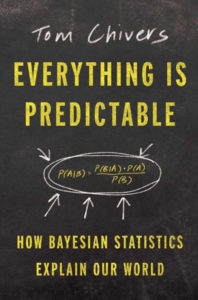While this column deals with books focused on leadership and technical issues for which almost every facility manager should have the appropriate knowledge to do the job well, there are some very technical topics that may be of more interest to the IT and mathematically focused personnel in the organization.
This month’s focus is on such a book.
As a reminder, this column welcomes guest book reviews. Advance permission is not needed; simply submit it to the editor. There are some great books and readers in APPA, this is an outlet to share what is available.
Everything is Predictable: How Bayesian Statistics Explain Our World
Chivers, Tom, Simon & Schuster, New York, 2024, 384 pages, e-book, $15, hardcover, $30.
 Facility managers are reliant on statistics to help identify how long facility components will last before they fail or must be replaced. What kind of service achieves the greatest occupant satisfaction at the least cost, and other important measures. Many are familiar with statistical measures that look at frequencies of occurrences resulting in a bell curve. From this, we get medians, standard deviations (sigma), and the goal of Six Sigma performance, six standard deviations from the median or 99.9999 percent operational reliability or less than one minute of service interruption in a year. However, there’s another way to look at statistics—Bayesian statistics. Tom Chivers’ most recent book on Bayesian statistics, Everything is Predictable, addresses many different reasons and applications for this method.
Facility managers are reliant on statistics to help identify how long facility components will last before they fail or must be replaced. What kind of service achieves the greatest occupant satisfaction at the least cost, and other important measures. Many are familiar with statistical measures that look at frequencies of occurrences resulting in a bell curve. From this, we get medians, standard deviations (sigma), and the goal of Six Sigma performance, six standard deviations from the median or 99.9999 percent operational reliability or less than one minute of service interruption in a year. However, there’s another way to look at statistics—Bayesian statistics. Tom Chivers’ most recent book on Bayesian statistics, Everything is Predictable, addresses many different reasons and applications for this method.
Rather than taking a technical or textbook approach to statistics, Chivers presents the application of statistics from a historical perspective. Who were the individuals developing statistical theories, why were they doing so, and what were the practical applications that drove the developments? In the process, Chivers presents the shortcomings of those who look at frequencies of occurrences, the “frequentists,” and what they are missing.
Most interesting in the background of many statisticians—Bayes in particular—was their association with religion. Thomas Bayes was a minister in the Nonconformist church (Presbyterian), meaning that they didn’t conform to the tenets of the Church of England. Bayes’ theorem focused on the problem of inverse probability which allowed one to predict an outcome given specific conditions. A classic example predicts the chances of drawing a black or white ball from an urn given a set of conditions. In some cases, the odds are surprising.
After presenting the history of statistics, and how different individuals used statistics and applied Bayes’ work, the author provides several examples related to current events and popular culture. Examples include medical diagnoses and the odds that you really have a condition following a test for the condition that includes false positives (when the test says you have tested positive but are actually negative). Another fun example comes from TV’s Let’s Make a Deal, where a contestant has three choices to win a prize, and the host reveals one of the unselected choices. What are the odds for the contestant after the first reveal? It is not what most think. There is also some discussion about Artificial Intelligence (AI) and how Bayesian methods apply to it.
What does this have to do with facilities? As facility officers deal with limited budgets and the need to provide reliable services, they apply different techniques to ensure smooth operations. Predictive maintenance allows for savings over preventive maintenance; by applying Bayesian methods, it is possible to identify whether specific conditions from non-destructive tests recommend an expenditure or to just leave the equipment alone. That’s a gross simplification but one that can be used to come closer to achieving Six Sigma results without the cost of unneeded maintenance.
For readers interested in statistics or needing to think differently about how facilities are maintained, Everything is Predictable may be well worth the investment and time to read and understand how Bayesian statistics works and provides advantages to predicting the future without the use of a crystal ball. Alternatively, those who like the history of mathematics will find it a pleasant distraction from the daily grind.
APPA Fellow Theodore (Ted) Weidner, PhD, PE, RA, NCARB, DBIA, CEFP, is a professor of engineering practice at Purdue University, West Lafayette, Indiana. He can be reached at [email protected]. If you would like to write a book review, please contact Ted directly.
Bookshelf
Book reviews on current publications relevant to the profession, trends, and working environment of facilities and educational managers and professionals. To contribute a book review, contact Ted Weidner, field editor of this column.
See all Bookshelves.


